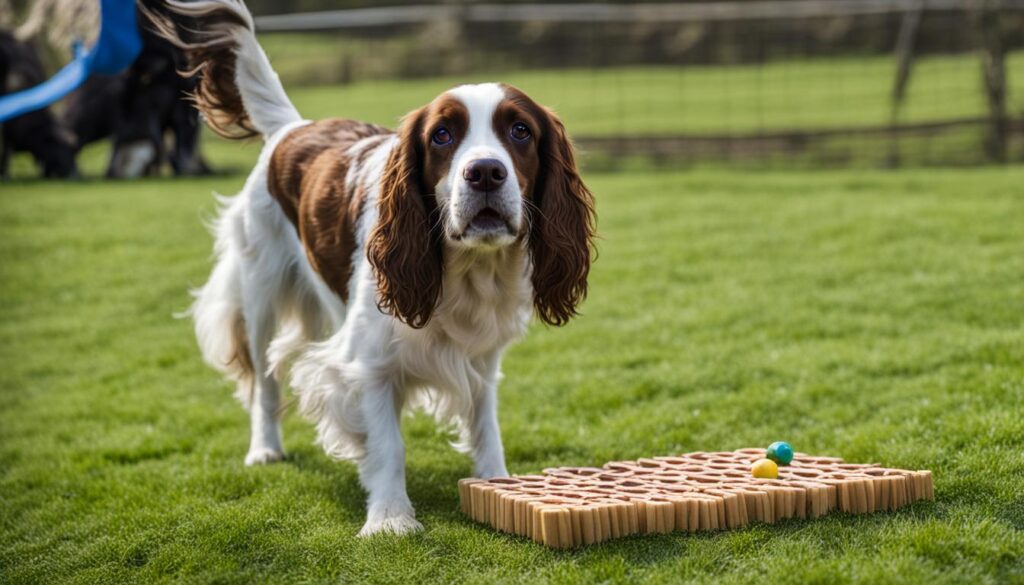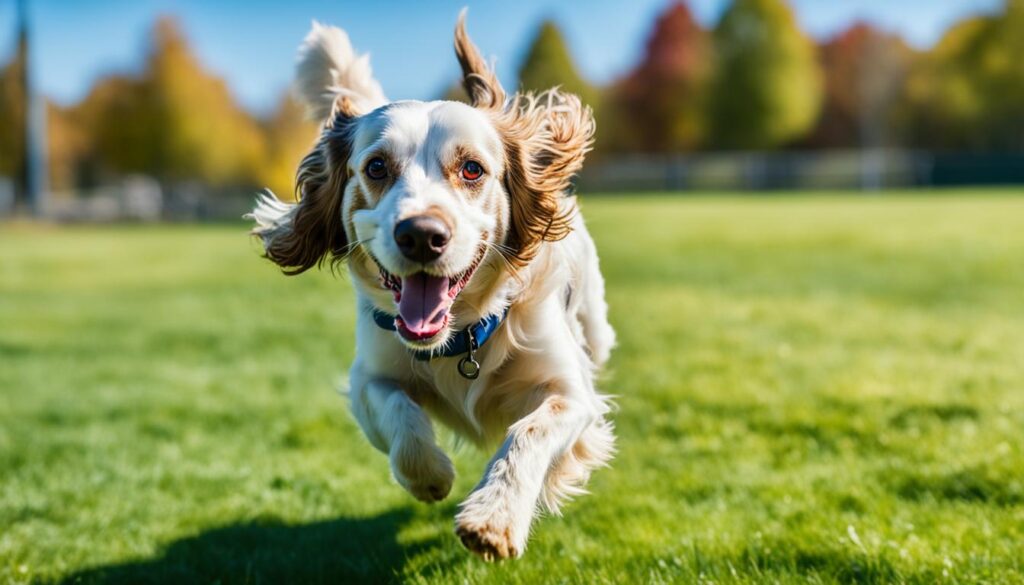Table of Contents
Are you looking for effective spaniel training techniques to ensure your furry companion’s obedience and behavior? Teaching your spaniel essential commands not only strengthens the bond between you but also provides them with the necessary skills for a safe and well-behaved lifestyle. Discover the power of positive reinforcement and proven training methods to transform your spaniel into a well-trained and responsive dog.
| Category | Commands | Purpose/Description |
|---|---|---|
| Basic Commands | Sit | Teaches the dog to sit on command, a fundamental for control and further training. |
| Stay | Instructs the dog to remain in a given position until released, crucial for safety and discipline. | |
| Come | Trains the dog to come to you when called, essential for recall and preventing unwanted behavior. | |
| Down | Directs the dog to lie down, useful for calming and control. | |
| Heel | Teaches the dog to walk beside you, maintaining a loose leash and proper walking etiquette. | |
| Behavioral Commands | Leave It | Instructs the dog not to touch or pick up something, important for safety and preventing theft. |
| Quiet | Trains the dog to stop barking on command, essential for noise control. | |
| Drop It | Commands the dog to release whatever is in its mouth, crucial for preventing ingestion of harmful objects. | |
| Advanced Commands | Fetch | Engages the dog in bringing back a thrown object, good for exercise and play. |
| Give | Teaches the dog to give an object in its mouth to you, useful for playing and retrieving items. | |
| Stay Until Called | A more advanced version of ‘Stay’, where the dog waits until called, regardless of distractions. |
This table outlines a structured approach to training your spaniel, starting from the basics to more advanced commands. Each command not only serves a practical purpose in everyday life but also strengthens the bond between you and your dog through effective communication and mutual respect.
The Basics of Spaniel Training
Before diving into training commands, it’s important to understand your spaniel’s training needs. Spaniels are intelligent, energetic dogs that require mental stimulation and physical exercise. By meeting these needs, you can set the foundation for successful spaniel training.
Understanding Your Spaniel’s Training Needs
Spaniels thrive on mental challenges and need activities that keep them engaged. Training sessions should be short but frequent, allowing your spaniel to stay focused and avoid becoming overwhelmed. Additionally, regular exercise is essential to burn off excess energy and prevent behavior problems. Both mental and physical stimulation are crucial for spaniel training success.
Identifying Appropriate Training Tools
Having the right tools for spaniel training can make a significant difference in the effectiveness of your sessions. Some common training tools include:
- A clicker: A small handheld device that makes a distinct clicking sound and helps mark desired behaviors.
- Dog treats: High-value treats that serve as positive reinforcement and motivate your spaniel to learn and obey commands.
- Training leash and collar: A sturdy leash and well-fitted collar are essential for control and safety during training sessions.
These tools can aid in the training process and make it easier for your spaniel to understand and respond to commands.
Establishing Trust and Positive Reinforcement
Building trust with your spaniel is vital for a successful training relationship. Use positive reinforcement techniques, such as rewards and praise, to motivate and encourage your spaniel during training. When your spaniel performs a desired behavior, immediately reward them with a treat or verbal praise. This positive reinforcement strengthens the association between the behavior and the reward, increasing the likelihood of it being repeated in the future.
A positive learning environment, based on trust and positive reinforcement, creates a strong bond between you and your spaniel. It also fosters a positive attitude towards training and enhances your spaniel’s willingness to learn and obey commands.
Mastering Recall with Your Spaniel
Recall is a crucial command for every spaniel owner. The ‘come’ command ensures your spaniel’s safety and can prevent accidents or dangerous situations. When your spaniel responds promptly to the recall command, it allows you to have control over their actions and keep them out of harm’s way. Whether you’re at the park, near a busy road, or in an unfamiliar environment, having a reliable recall command is essential.
The Lifesaving ‘Come’ Command
The ‘come’ command is a lifesaving cue that can be invaluable in emergency situations or when you need to quickly regain control of your spaniel. To teach your spaniel the recall command:
- Find a quiet and distraction-free area to start your training sessions.
- Make sure your spaniel is on a leash or in a secure enclosed space.
- Call your spaniel’s name in an enthusiastic, upbeat tone, followed by the command “come.”
- Offer a reward, such as a treat or praise, when your spaniel responds and comes to you.
- Gradually increase the difficulty by practicing the recall command in different environments and with increasing distractions.
Consistency, positive reinforcement, and patience are key for successful recall training. Remember to always reward your spaniel for coming to you promptly, even if they were initially distracted or took longer to respond.
Teaching the ‘Stay’ Command for Safety
The ‘stay’ command is another essential cue that can keep your spaniel safe in various situations. Whether you need your spaniel to stay in place while you answer the door or wait for permission before crossing a road, teaching the ‘stay’ command is crucial.
- Start by asking your spaniel to sit or lie down in a comfortable position.
- Present an open palm toward your spaniel, using the cue “stay” or another chosen command.
- Take a step back and wait for a few seconds before returning to your spaniel and offering a reward.
- Gradually increase the duration of the stay command, always returning to your spaniel to provide positive reinforcement.
Practicing the ‘stay’ command in various scenarios will help your spaniel generalize the behavior and stay in place until released. It’s important to remember that teaching your spaniel the ‘stay’ command takes time and practice, so be patient and consistent throughout the training process.
Essential Potty Training Practices
Potty training is an essential aspect of spaniel training to ensure a clean living environment and good hygiene for both you and your spaniel. Here are some essential potty training practices:
- Establish a routine: Take your spaniel outside to the designated potty area at regular intervals, especially after meals or naps.
- Use positive reinforcement: Reward your spaniel with treats, praise, or play when they eliminate in the appropriate area.
- Be consistent: Use consistent verbal cues, such as “go potty” or “do your business,” to help your spaniel associate the command with the desired behavior.
- Monitor and supervise: Keep a close eye on your spaniel during potty training to prevent accidents and provide immediate reinforcement for eliminating in the right place.
By following these potty training practices and maintaining consistency, your spaniel will learn to associate the designated potty area with the act of elimination, leading to fewer accidents and a well-behaved spaniel.

Advanced Spaniel Training Techniques
Once your spaniel has mastered the basic commands, you can further enhance their training with advanced techniques. These techniques go beyond the foundational commands and allow you to teach your spaniel complex tricks and address specific behavioral issues through behavior modification.
Advanced spaniel training techniques require patience, consistency, and a deep understanding of your spaniel’s individual needs. By applying these techniques, you can continue to strengthen the bond between you and your furry companion, while also challenging them mentally and physically.
Teaching Complex Tricks
Advanced spaniel training includes teaching your dog complex tricks that go beyond the basic commands. This can include tricks like playing dead, rolling over, or jumping through hoops. By breaking down these tricks into smaller steps and using positive reinforcement, you can gradually train your spaniel to perform impressive tricks that will amaze your friends and family.
Behavior Modification
Behavior modification techniques are essential for addressing specific behavioral issues in your spaniel. Advanced spaniel training allows you to work on modifying behaviors such as excessive barking, jumping, or separation anxiety. Through positive reinforcement and consistent training, you can help your spaniel overcome these challenges and develop more desirable behaviors.
| Advanced Spaniel Training Techniques | Benefits |
|---|---|
| Teaching complex tricks | Provides mental stimulation and strengthens the bond |
| Addressing specific behavioral issues | Improves overall behavior and promotes a harmonious household |
| Enhancing problem-solving skills | Helps your spaniel think critically and adapt to new situations |
| Building confidence | Boosts your spaniel’s self-esteem and reduces fearfulness |
By incorporating advanced spaniel training techniques into your training routine, you can continue to challenge and stimulate your spaniel while strengthening your bond. Remember to be patient, consistent, and understanding of your spaniel’s individual needs throughout the training process.

Spaniel Behavioral Modification and Socialization
Behavior modification is a crucial aspect of spaniel training, aimed at addressing any undesirable behaviors exhibited by your furry friend. It involves implementing techniques such as positive reinforcement, desensitization, and counter-conditioning to modify your spaniel’s behavior in a positive and effective manner.
One method of behavior modification is utilizing positive reinforcement, which involves rewarding your spaniel for desirable behaviors, such as obeying commands or displaying good manners. By associating positive experiences and rewards with the desired behavior, you can effectively encourage your spaniel to repeat the behavior in the future.
Another technique is desensitization, which involves gradually exposing your spaniel to the stimulus or situation that triggers their unwanted behavior. Through controlled and incremental exposure, your spaniel can learn to remain calm and composed, eventually overcoming their fear or anxiety.
Counter-conditioning is yet another valuable approach in behavior modification. It involves changing your spaniel’s emotional response to a particular trigger by associating it with a positive experience. For example, if your spaniel exhibits fear towards thunderstorms, you can introduce pleasant activities, such as playing with their favorite toy, during a storm to help them associate it with positive feelings.
Socialization is also an essential aspect of spaniel training and plays a significant role in their overall behavior. It involves exposing your spaniel to various people, animals, and environments in a positive and controlled manner. This exposure helps your spaniel develop positive interactions and comfortable experiences with different stimuli, which in turn contributes to their confidence and well-rounded behavior.
Elevating Obedience: From Basic Commands to Complex Tricks
Taking your spaniel’s obedience to the next level involves teaching them complex tricks beyond basic commands like ‘sit’ and ‘down.’ By expanding their training repertoire, you can challenge their cognitive abilities and enhance their overall obedience skills.
Moving Beyond ‘Sit’ and ‘Down’ – Teaching ‘Roll over’ and ‘Paw’
Once your spaniel has mastered the foundational commands, you can introduce more advanced tricks like ‘roll over’ and ‘paw.’ These tricks require patience, consistency, and a gradual step-by-step approach. Start by breaking down the trick into smaller parts and rewarding your spaniel for each successful attempt. With consistent practice and positive reinforcement, your spaniel will learn to perform these complex tricks with grace and precision.
Channeling Energy through ‘Play’ and ‘Fetch’ Commands
Spaniels are known for their abundant energy, and it’s essential to provide them with appropriate outlets to channel that energy. Commands like ‘play’ and ‘fetch’ not only engage your spaniel physically but also stimulate their mind. Playing interactive games and engaging in regular exercise sessions can help manage their energy levels and prevent destructive behaviors. Incorporate toys, scent games, and puzzle toys into your spaniel’s training routine to keep them mentally stimulated and well-behaved.
In conclusion, expanding your spaniel’s training beyond basic obedience commands to include complex tricks and energy management activities can enrich their lives and strengthen the bond between you. By investing time and effort into their training, you can enjoy a well-behaved and mentally fulfilled spaniel companion.
Conclusion
Revisiting the Importance of Consistent Spaniel Training
Consistent spaniel training is essential for raising a well-behaved and obedient companion. By investing time and effort into training your spaniel, you can establish a strong bond and a positive relationship. Spaniels are intelligent and energetic dogs that require mental stimulation and physical exercise. Training helps fulfill these needs and ensures their safety and well-being.
Final Thoughts on Raising a Well-trained Spaniel Companion
Using positive reinforcement techniques and understanding your spaniel’s individual needs are key factors in successful training. Positive reinforcement, such as rewards, praise, and treats, creates a positive learning environment. It motivates your spaniel to respond to commands and encourages them to exhibit desirable behaviors. Additionally, training provides mental stimulation for your spaniel, keeping them engaged and content.
Raising a well-trained spaniel requires patience, consistency, and dedication. By utilizing effective training methods and building a trusting relationship, you can transform your spaniel into a well-behaved and happy furry companion. Remember to always approach training with kindness, understanding, and a positive attitude.
Last update on 2024-04-15 / Affiliate links / Images from Amazon Product Advertising API







